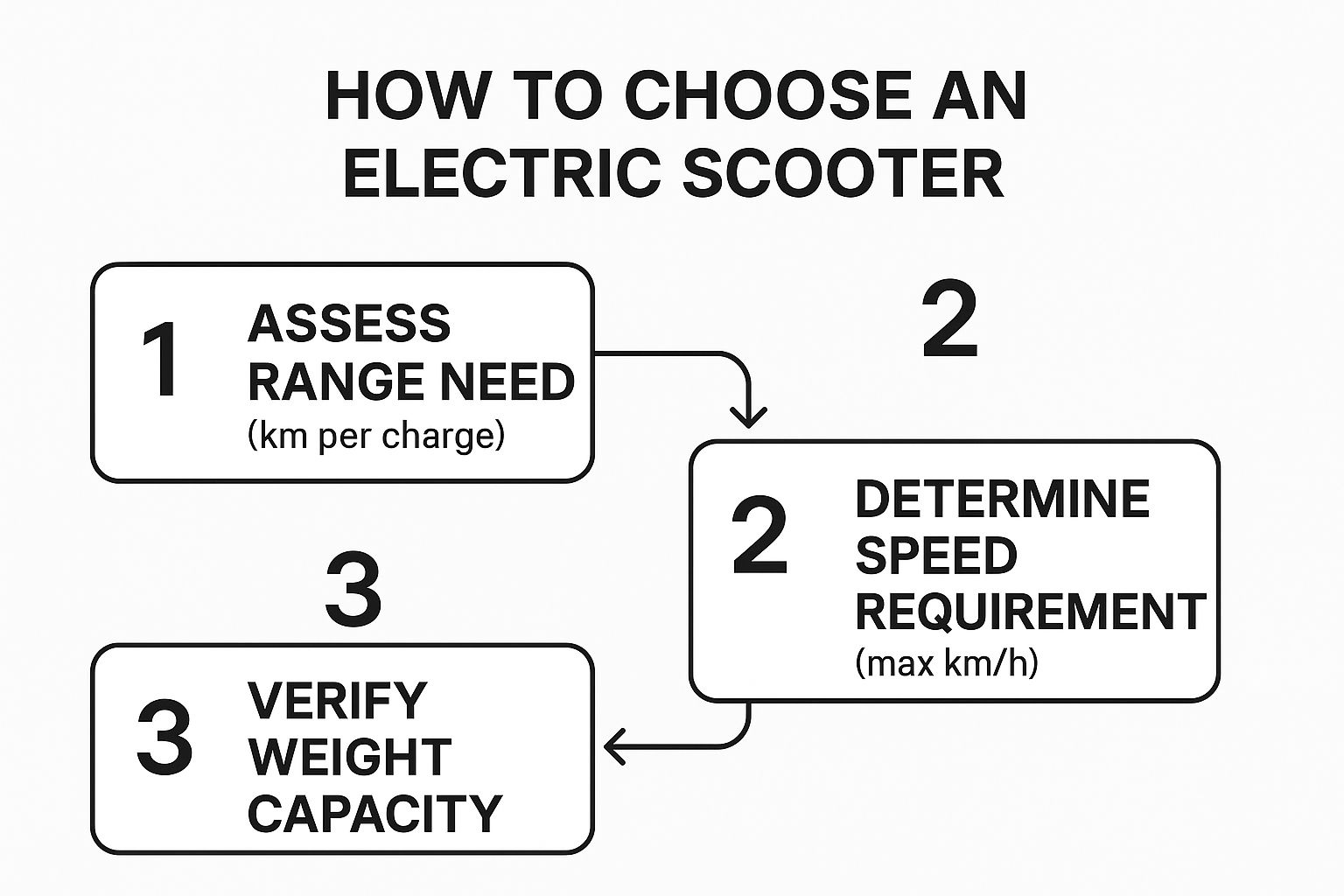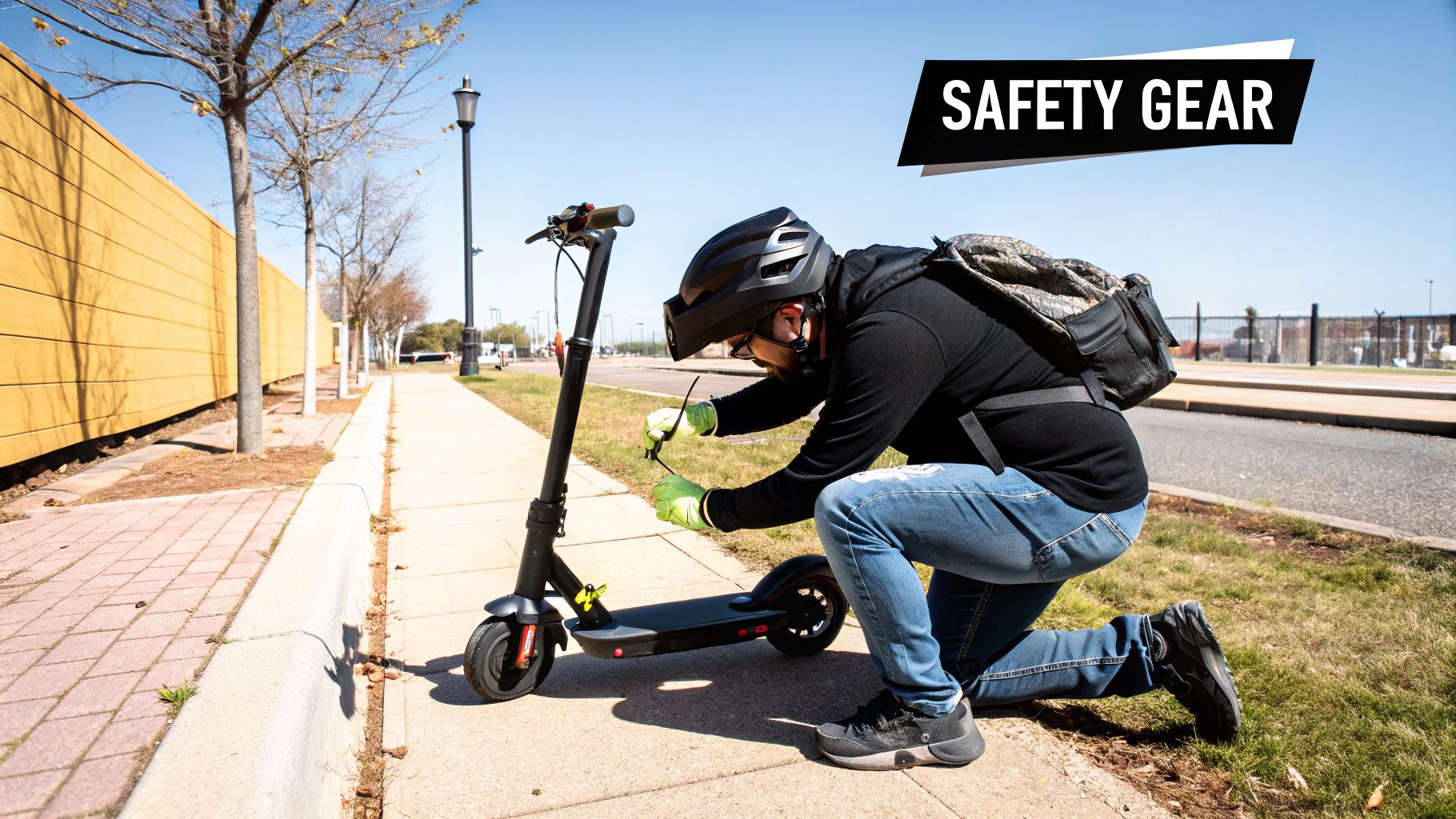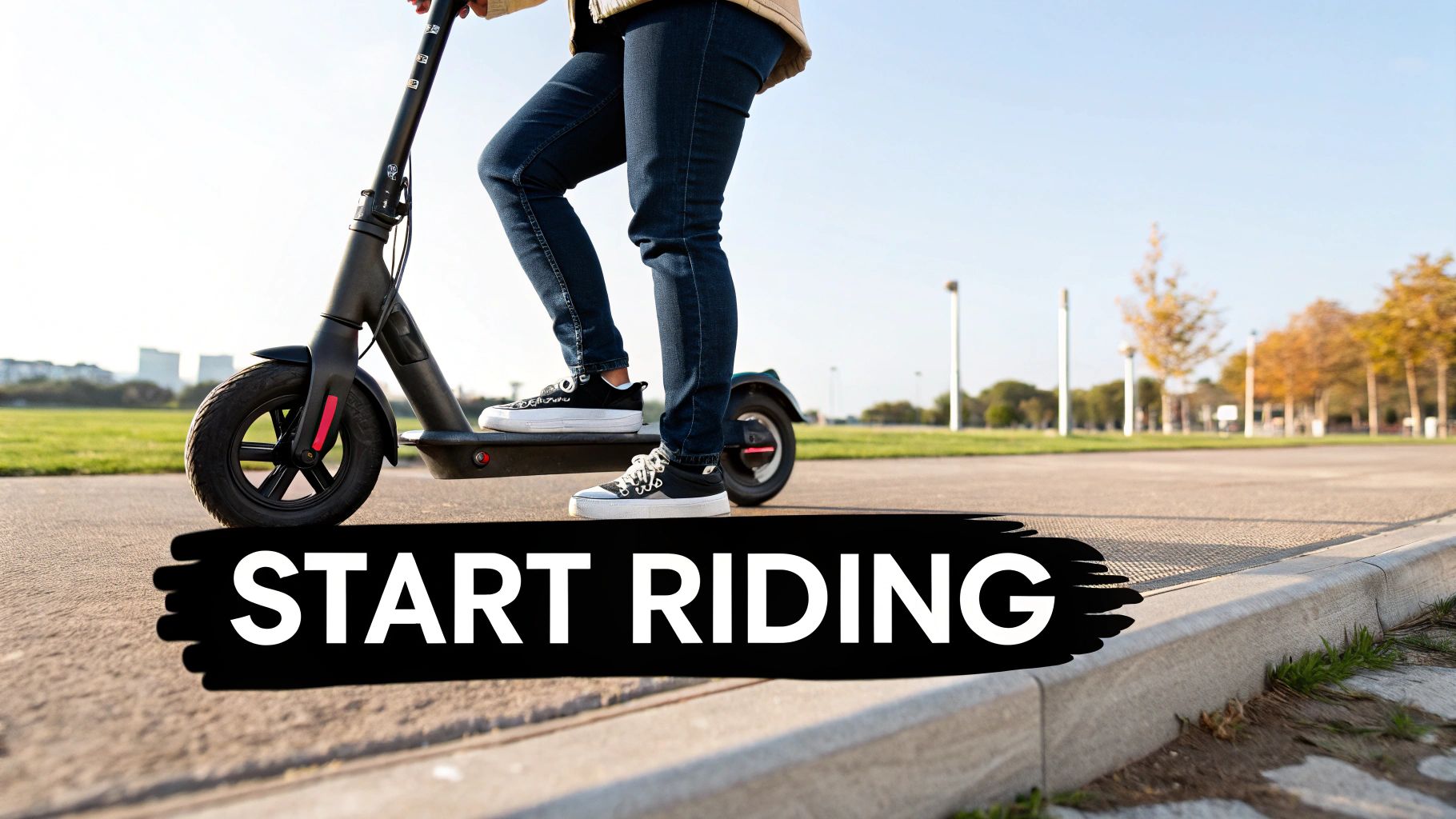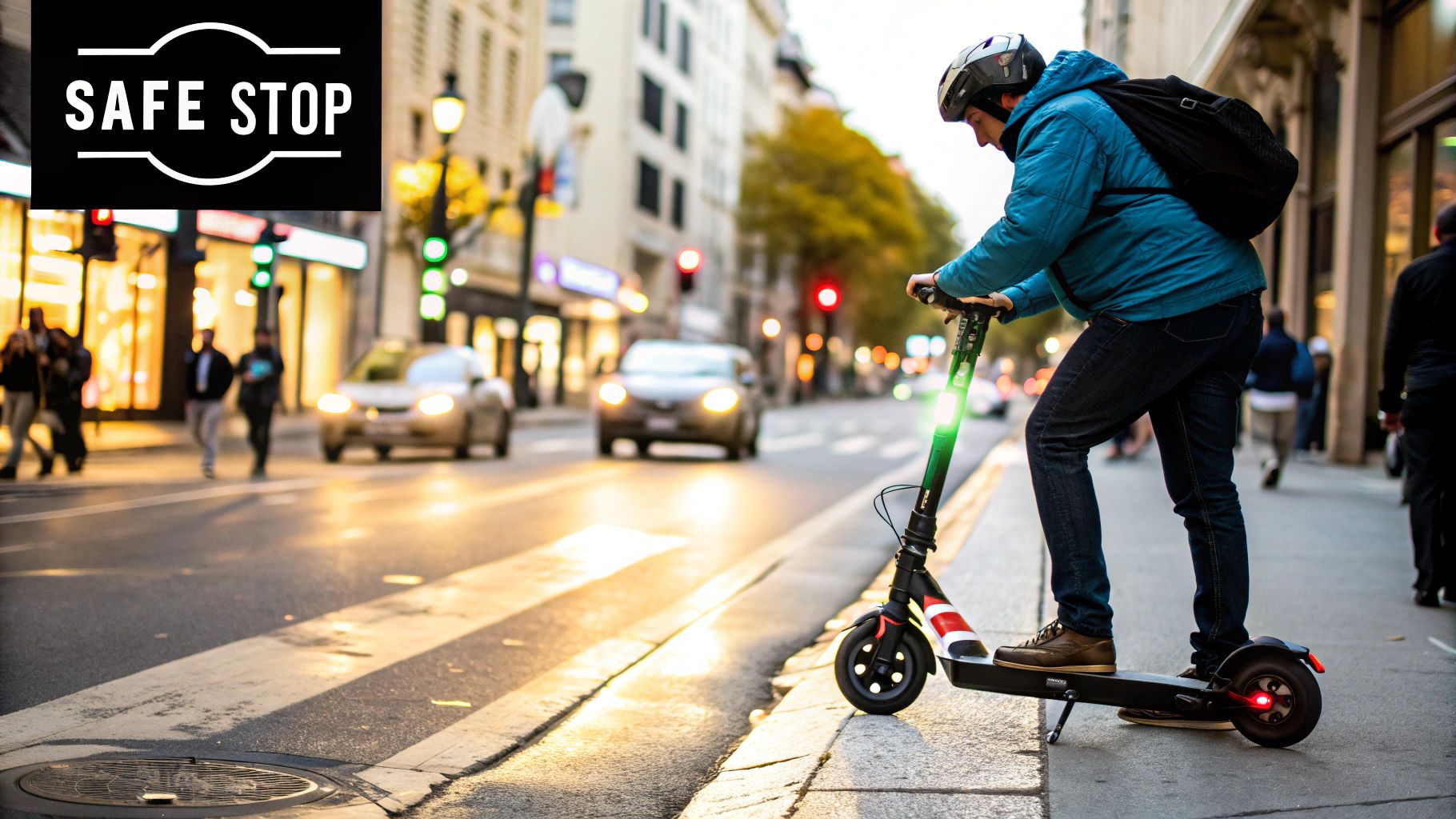Alright, let's get you ready for your first spin. Riding an electric scooter is a blast, but mastering the basics first is what turns a wobbly start into a smooth, confident ride. It's all about balance and getting a feel for the controls.
Your First Ride Without the Wobbles
Before you even think about hitting the throttle, we need to do a quick "pre-flight check." Getting comfortable on a scooter is about building confidence from the ground up, not just gunning it from the get-go. This little routine is non-negotiable for safety and will turn those first-ride jitters into pure excitement.
The Quick Pre-Ride Once-Over
Every single ride should start with a quick check. Seriously, it takes less than a minute and can save you from a lot of hassle.
Here’s a quick table to make it easy to remember.
Your Pre-Ride Safety Checklist
This is the essential checklist I run through before every single trip. It's a simple habit that makes a world of difference.
| Check Item | Why It Matters | How to Check |
|---|---|---|
| Battery Level | You don't want to get stranded and have to carry your scooter home. Trust me, it's not fun. | Power on the scooter and look at the display. Is it fully charged or close to it? |
| Brakes | This one's a no-brainer. You need to be able to stop safely and quickly. | Squeeze the brake levers. They should feel firm, not spongy. Roll the scooter a few feet and test them. |
| Tire Pressure | Proper inflation gives you better control, a smoother ride, and helps prevent flats. | Give the tires a firm squeeze. They should feel solid. If you have a gauge, check they match the recommended PSI. |
Doing these three simple things will ensure your scooter is in good shape and ready to roll.
Finding Your Footing First
Now, find a good spot to practice. A quiet, empty parking lot or a smooth park path is perfect—anywhere you won't have to worry about cars or people.
With the scooter's power still off, step onto the deck. Get a feel for how it balances and how your weight shifts affect it. Kick off the ground a few times like you would on a regular kick scooter. This is all about building muscle memory without any of the risk. Getting this part down is crucial to understanding the psychology of electric scooter riding and tapping into that sense of freedom.
Making sure you have the right scooter for your needs is a big part of having a good first experience. This infographic gives a great breakdown.

If you match the scooter's range, speed, and weight limit to what you'll actually be doing, your first ride will be so much safer and more enjoyable.
Thankfully, learning is way easier than it used to be. Older scooters with those clunky lead-acid batteries were a pain to handle. Modern ones use lightweight lithium-ion batteries, making them far more responsive and easier to balance. Plus, many have smart features like apps that let you keep an eye on your battery and track your rides right from your phone.
Getting the Hang of the Throttle and Brakes
Alright, this is where the real fun begins. Learning to handle your scooter's throttle and brakes is what separates a wobbly first-timer from a smooth, confident rider. It’s all about developing a feel for the controls.
Forget everything you think you know about hitting the gas. On an e-scooter, it's all about finesse. Whether you've got a thumb-press throttle or a motorcycle-style twist grip, the golden rule is less is more. A sudden jam on the throttle will send the scooter lurching forward, and you'll be left trying to regain your balance. Slow and steady wins this race.

Feeling Out the Acceleration
So, how do you actually start? With the scooter powered on, plant one foot on the deck and give a gentle push off with your other foot, just like a regular kick scooter. As you start rolling, then you can apply the slightest bit of pressure to the throttle. You're trying to get the motor to smoothly take over from your kick—no sudden jerks.
Remember, these aren't toys. Most electric scooters can hit speeds between 15 to 25 mph (24 to 40 km/h), and that feels a lot faster when you're standing on a small platform. Unlike a bike, the instant torque from the motor can catch you off guard, which is why a gentle kick-start and gradual acceleration are so important for staying stable. If you're curious about the tech that powers these rides, this electric scooter market report goes deep into the mechanics.
Mastering the Brakes
Getting going is only half the battle; stopping safely is arguably more important. Your scooter might have a few different braking systems: a classic hand brake, a rear fender you press down with your foot, or even regenerative braking that kicks in when you let off the throttle.
Get a feel for them one at a time. Roll forward at a snail's pace and gently squeeze the hand brake or tap the foot brake. See how it responds. You don’t want to discover how sensitive they are when you actually need to stop in a hurry.
My Two Cents: Think of your rear brake as your go-to for slowing down gradually. The front brake has a lot more stopping power, so it needs a lighter touch to avoid pitching you forward. In most everyday situations, using a bit of both is the secret to a smooth, controlled stop.
Ready to put it all together? Find an empty parking lot or a wide-open patch of pavement and try this little drill.
- Kick and Go: Give a little kick to get rolling.
- Gentle Acceleration: Smoothly apply the throttle and ride for about 30 feet at a comfortable walking speed.
- Smooth Stop: Gently apply your brakes to come to a complete, controlled stop.
- Rinse and Repeat: Do this again. And again. And again. Repetition is what builds that muscle memory so you can react without thinking.
The key is to "feather" the controls. Think of it as making tiny, constant adjustments instead of mashing the throttle or slamming on the brakes. After just a few minutes of this, you'll feel a world more confident and in control.
Finding Your Flow with Balancing and Turning
Alright, now that you've got the hang of the throttle and brakes, it's time for the best part: actually gliding around. This is where you really start to feel connected to the scooter, and balancing and turning become second nature. It’s less about wrestling with the handlebars and more like a fluid dance.

The secret to staying stable while you're moving is keeping a low center of gravity. Bend your knees just a bit and try to stay relaxed. If you're stiff and rigid, you'll feel every single bump and wobble, which usually leads to overcorrecting.
Instead, think of it like surfing or skateboarding. You use tiny shifts in your body weight to maintain balance. It's your body doing the work, not just your arms on the handlebars. Getting this fluid motion down is the key to riding with confidence.
Leaning Into Your Turns
When you need to make a turn, your first instinct might be to yank the handlebars in that direction. Don't do it! Smooth, controlled turns are all about leaning.
Start by looking where you want to go—seriously, your body has a funny way of following your eyes. As you head into the turn, just shift your weight and lean gently in that direction. You'll find the handlebars follow along almost on their own. It’s a cool bit of physics that feels surprisingly natural once you get it.
Rookie Mistake Alert: The biggest turning mistake I see is people looking down at their front wheel or their feet. It completely throws off your balance. Always keep your eyes up and looking through the turn to where you want to end up.
Head back to your practice spot and try carving some long, lazy "S" shapes. This is the perfect way to build muscle memory for leaning without tensing up or oversteering. A few runs of this, and you'll feel way more in sync with the scooter, turning with your whole body instead of just your hands.
Riding Safely in the Real World
https://www.youtube.com/embed/PJYMovHiv7w
Alright, you've mastered the basics in an empty parking lot. Now it's time for the real deal: taking your scooter out onto actual streets. This is where things get interesting. You'll be dealing with everything from pedestrians and traffic to surprise potholes and drivers who just aren't paying attention.
The name of the game is defensive riding. You have to learn to anticipate what could happen, not just what is happening.
Think of it as creating a personal "safety bubble." This means you're constantly scanning your environment—what’s ahead, what’s coming up behind you, and what’s happening on either side. A quick shoulder check before you turn or switch lanes is absolutely essential. It’s a tiny habit, but it’s one that will save you from a world of trouble.
Navigating the Urban Jungle
Riding in a city means you’re sharing the road, and you're the smallest one out there. In many US cities and Australian states, you'll be in bike lanes or sharing the road with traffic. You have to assume someone might step out from behind a parked car or that a car door will swing open right in front of you.
Always give parked cars a wide berth and slow way down when you approach an intersection, even when you have the right of way.
A huge part of staying safe is making sure everyone else knows what you're about to do. Don't ever assume a driver or a cyclist can read your mind. Use hand signals and use them early:
- Turning Left: Stick your left arm straight out.
- Turning Right: Stick your right arm straight out (or you can bend your left arm up at a 90-degree angle).
- Stopping: Bend your left arm down at a 90-degree angle, with your palm facing behind you.
These simple signals make you predictable, and being predictable is what keeps everyone on the road safe.
Adapting to Different Terrains
The ground beneath your wheels changes everything. Smooth, dry pavement is a dream, but you won't always have it. You're going to run into potholes, patches of gravel, and slippery wet leaves, all of which can mess with your grip.
When you see a hazard coming up, slow down before you get to it. Go around it if you can. If you have no choice but to ride over it, try to keep the scooter as upright as possible and stay loose—don't tense up.
How a rider behaves is a massive piece of the safety puzzle. Studies show that fall-related injuries account for nearly 40% of all e-scooter trips to the ER, usually because a new rider gets a little too confident and misjudges their speed or the terrain. The key is to adapt. You can go faster on smooth pavement, but the second it gets wet or gravelly, you need to dial it back.
The good news is that scooter safety is improving as more people start riding. You can learn more about how market trends are shaping scooter safety and see how things are improving.
Here’s the most important takeaway for any new rider: always ride within your comfort zone. If a street feels too crowded or a path looks too rough, it's okay to slow down or even get off and walk. Knowing your own limits is just as crucial as knowing how to ride the scooter itself.
Your Essential Gear and the Lowdown on US & Australian Scooter Laws
 Before you even think about hopping on, let's talk about the two most important things: your gear and the rules of the road. Getting these right isn't just a suggestion—it's absolutely essential.
Before you even think about hopping on, let's talk about the two most important things: your gear and the rules of the road. Getting these right isn't just a suggestion—it's absolutely essential.
Your helmet is, without a doubt, the most critical piece of equipment you'll own. Seriously. A good one can be the difference between a minor spill and a life-altering injury. I find that a quality light cycling helmet is perfect for most riders, offering solid protection without feeling like you're wearing a giant melon on your head.
While the helmet is non-negotiable, a few other items can make your rides much safer and more comfortable:
- Reflective Clothing: If you’re riding at dawn, dusk, or night, this is a must. You need to be seen.
- Gloves: They do more than just keep your hands warm. They improve your grip and can save your palms from some nasty scrapes if you happen to take a tumble.
Navigating E-Scooter Regulations
Okay, now for the legal stuff, and this is where you really need to pay attention. E-scooter laws vary wildly between different states and even cities, so what’s legal in one place might not be in another.
In the United States, there's no single federal law. It's up to each state. For example, in California, you can ride in bike lanes, while other states might have different rules about where you can ride and how fast you can go. In Australia, laws also differ by state. Queensland and Western Australia have embraced e-scooters with clear rules for private owners, while others are still in trial phases.
The most important thing you can do is check your local regulations before you ride. A quick search for "[Your City/State] electric scooter laws" will usually give you the specific rules you need to follow regarding speed limits, helmet use, and where you're allowed to ride.
Got Questions? We've Got Answers
If you're new to the world of e-scooters, it's totally normal to have a few questions swirling around. In fact, it’s a good thing! It shows you're taking safety seriously and want to start off on the right foot. Let's tackle some of the most common things new riders ask.
How Long Until I Get the Hang of It?
Honestly, not long at all. Most people start to feel pretty comfortable with the essentials—like balancing, using the throttle smoothly, and braking—within the first 15 to 30 minutes.
Just find a nice, open area without any obstacles. Once you nail those basics, getting confident with sharper turns and navigating different kinds of pavement just takes a few more rides.
What's the #1 Mistake Newbies Make?
Oh, this one's easy. By far, it's jamming the throttle on your first go. That sudden burst of power creates a jerk that'll throw you off balance in a heartbeat. The key is to think of the throttle like a dimmer switch, not a light switch—apply slow, steady pressure for a smooth start.
Another classic mistake is staring down at your feet. Your scooter will go where your eyes are looking, so keep your head up and focused on the path ahead. It makes a world of difference for your balance.
Here's a pro tip for a perfect start every time: give a little kick-push to get rolling before you even touch the throttle. That tiny bit of momentum prevents the motor from lurching and gives you a much more stable takeoff.
Is It Okay to Ride My E-Scooter in the Rain?
This is a tricky one. While most modern scooters have some water resistance (you'll want to check your model's IP rating), I generally advise against riding in the rain, especially when you're new.
Wet pavement means way less traction, and your tires can easily slip out from under you when you turn or brake. If you absolutely have to ride on wet streets, take it slow—like, really slow—and give yourself double the stopping distance you normally would.
We've got a ton more answers and tips waiting for you. Head over to our complete electric scooter FAQs to learn even more.
Ready to find the perfect ride to start your journey? At Punk Ride, we offer a curated selection of top-tier electric scooters designed for safety, performance, and style. Find your perfect match and redefine your commute at https://www.punkride.com.
Article created using Outrank




Share:
The Psychology of Electric Scooter Riding: Experiencing Freedom and Joy
How to Lock Electric Scooter Safely | Expert Tips